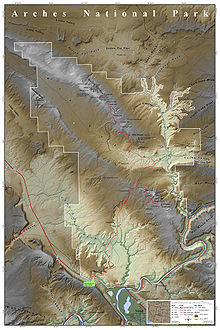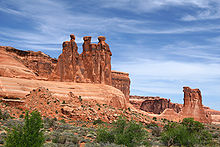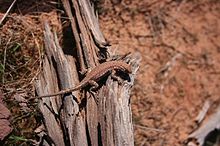- Arches National Park
-
Arches National Park Location Grand County, Utah, United States Nearest city Moab, Utah Coordinates 38°41′00″N 109°34′00″W / 38.68333°N 109.56667°WCoordinates: 38°41′00″N 109°34′00″W / 38.68333°N 109.56667°W Area 76,679 acres (31,031 ha)[1] Established April 12, 1929, as a National Monument Visitors 1,014,405 (in 2010)[2] Governing body National Park Service Arches National Park is a U.S. National Park in eastern Utah. It is known for preserving over 2000 natural sandstone arches, including the world-famous Delicate Arch, in addition to a variety of unique geological resources and formations.
The park is located just outside of Moab, Utah, and is 76,679 acres (31,031 ha) in area. Its highest elevation is 5,653 feet (1,723 m) at Elephant Butte, and its lowest elevation is 4,085 feet (1,245 m) at the visitor center. Forty-three arches have collapsed due to erosion since 1970. The park receives 10 inches (250 mm) of rain a year on average.
Administered by the National Park Service, the area was originally created as a National Monument on April 12, 1929. It was redesignated as a National Park on November 12, 1971.[3]
Contents
Geology
The national park lies atop an underground evaporite layer or salt bed, which is the main cause of the formation of the arches, spires, balanced rocks, sandstone fins, and eroded monoliths in the area. This salt bed is thousands of feet thick in places, and was deposited in the Paradox Basin of the Colorado Plateau some 300 million years ago when a sea flowed into the region and eventually evaporated. Over millions of years, the salt bed was covered with debris eroded from the Uncompahgre Uplift to the northeast. During the Early Jurassic (about 210 Ma) desert conditions prevailed in the region and the vast Navajo Sandstone was deposited. An additional sequence of stream laid and windblown sediments, the Entrada Sandstone (about 140 Ma), was deposited on top of the Navajo. Over 5000 feet (1500 m) of younger sediments were deposited and have been mostly eroded away. Remnants of the cover exist in the area including exposures of the Cretaceous Mancos Shale. The arches of the area are developed mostly within the Entrada formation.[4]
The weight of this cover caused the salt bed below it to liquefy and thrust up layers of rock into salt domes. The evaporites of the area formed more unusual salt anticlines or linear regions of uplift.[4] Faulting occurred and whole sections of rock subsided into the areas between the domes. In some places, they turned almost on edge. The result of one such 2,500-foot (760 m) displacement, the Moab Fault, is seen from the visitor center.
As this subsurface movement of salt shaped the landscape, erosion removed the younger rock layers from the surface. Except for isolated remnants, the major formations visible in the park today are the salmon-colored Entrada Sandstone, in which most of the arches form, and the buff-colored Navajo Sandstone. These are visible in layer cake fashion throughout most of the park. Over time, water seeped into the surface cracks, joints, and folds of these layers. Ice formed in the fissures, expanding and putting pressure on surrounding rock, breaking off bits and pieces. Winds later cleaned out the loose particles. A series of free-standing fins remained. Wind and water attacked these fins until, in some, the cementing material gave way and chunks of rock tumbled out. Many damaged fins collapsed. Others, with the right degree of hardness and balance, survived despite their missing sections. These became the famous arches.
Climate
Temperatures in Arches National Park vary by month, as does the precipitation. Generally, the hottest month is July. The coolest month is January. October sees the most precipitation in the park. Snow is not an uncommon thing to see during the winter months.
Climate data for Arches National Park Month Jan Feb Mar Apr May Jun Jul Aug Sep Oct Nov Dec Year Record high °F (°C) 61
(16)71
(22)82
(28)89
(32)98
(37)104
(40)107
(42)105
(41)99
(37)90
(32)76
(24)67
(19)107
(42)Average high °F (°C) 37
(3)47
(8)57
(14)65
(18)76
(24)88
(31)94
(34)91
(33)82
(28)69
(21)52
(11)40
(4)69 Average low °F (°C) 19
(−7)25
(−4)33
(1)38
(3)47
(8)57
(14)63
(17)61
(16)53
(12)41
(5)30
(−1)22
(−6)41 Record low °F (°C) −8
(−22)−14
(−26)9
(−13)20
(−7)30
(−1)37
(3)41
(5)41
(5)29
(−2)20
(−7)3
(−16)−10
(−23)−14
(−26)Precipitation inches (mm) 0.65
(16.5)0.67
(17)1.15
(29.2)0.99
(25.1)1.05
(26.7)0.41
(10.4)0.88
(22.4)0.76
(19.3)0.83
(21.1)1.62
(41.1)0.99
(25.1)0.68
(17.3)10.59
(269)Source: weather.com [5] History
Humans have occupied the region since the last ice age 10,000 years ago. Fremont people and Ancient Pueblo People lived in the area up until about 700 years ago. Spanish missionaries encountered Ute and Paiute tribes in the area when they first came through in 1775, but the first European-Americans to attempt settlement in the area were the Mormon Elk Mountain Mission in 1855, who soon abandoned the area. Ranchers, farmers, and prospectors later settled Moab in the neighboring Riverine Valley in the 1880s. Word of the beauty in the surrounding rock formations spread beyond the settlement as a possible tourist destination.
The Arches area was first brought to the attention of the National Park Service by Frank A. Wadleigh, passenger traffic manager of the Denver and Rio Grande Western Railroad. Wadleigh, accompanied by railroad photographer George L. Beam, visited the area in September 1923 at the invitation of Alexander Ringhoffer, a Hungarian-born prospector living in Salt Valley. Ringhoffer had written to the railroad in an effort to interest them in the tourist potential of a scenic area he had discovered the previous year with his two sons and a son-in-law, which he called the "Devil's Garden" (known today as the "Klondike Bluffs"). Wadleigh was impressed by what Ringhoffer showed him, and suggested to Park Service director Stephen T. Mather that the area be made a national monument.
The following year, additional support for the monument idea came from Laurence Gould, a University of Michigan graduate student (and future polar explorer) studying the geology of the nearby La Sal Mountains, who was shown the scenic area by retired local physician Dr. J. W. "Doc" Williams.
A succession of government investigators examined the area, in part due to confusion as to the precise location. In the process, the name "Devil's Garden" was transposed to an area on the opposite side of Salt Valley, and Ringhoffer's original discovery was omitted, while another area nearby, known locally as "The Windows", was included. Designation of the area as a national monument was supported by the Park Service from 1926, but was resisted by President Calvin Coolidge's Interior Secretary, Hubert Work. Finally in April 1929, shortly after his inauguration, President Herbert Hoover signed a presidential proclamation creating Arches National Monument, consisting of two comparatively small, disconnected sections. The purpose of the reservation under the 1906 Antiquities Act was to protect the arches, spires, balanced rocks, and other sandstone formations for their scientific and educational value. The name "Arches" was suggested by Frank Pinkely, superintendent of the Park Service's southwestern national monuments, following a visit to the Windows section in 1925.
In late 1938, President Franklin D. Roosevelt signed a proclamation which enlarged Arches to protect additional scenic features and permit development of facilities to promote tourism. A small adjustment was made by President Dwight Eisenhower in 1960 to accommodate a new road alignment.
In early 1969, just before leaving office, President Lyndon B. Johnson signed a proclamation substantially enlarging Arches. Two years later, President Richard Nixon signed legislation enacted by Congress which significantly reduced the total area enclosed, but changed its status to a National Park.
Recreational activities
Climbing on named arches within the park has long been banned by park regulations. Following Dean Potter's successful free climb on the Delicate Arch in May 2006, however, the wording of the regulations was deemed unenforceable by the park attorney. The park revised its regulations as follows in response:
All rock climbing or similar activities on any arch or natural bridge named on the United States Geological Survey 7.5 minute topographical maps covering Arches National Park are prohibited.[6]Climbing on other features in the park is allowed, but regulated. The revised regulations also prohibit slacklining parkwide. Approved recreational activities include auto touring, backpacking, biking, camping, and hiking, some of which require permits. Guided commercial tours and ranger programs are also available.
Astronomy is also popular in the park due to its dark skies despite the increasing light pollution from towns like Moab.[7][8]
Publicity
American writer Edward Abbey was a park ranger at Arches National Monument where he kept journals that became his book Desert Solitaire. The success of this book, as well as the rise in adventure-based recreation, has drawn many hikers, mountain-bikers, and off-road enthusiasts to the area, but activities are limited within park boundaries: camping, foot hiking (along designated trails), and driving only along marked roads.
Biology
There is an abundance of wildlife in Arches. The list includes: spadefoot toad, scrub jay, peregrine falcon, many kinds of sparrows, red Fox, desert bighorn sheep, kangaroo rat, mule Deer, mountain lion, midget faded rattlesnake, yucca moth, many types of cyanobacteria, Western rattlesnake, and the Western collared lizard.
Plants also dominate the landscape in the park. The list of plants includes: prickly pear cactus, Indian ricegrass, bunch grasses, cheatgrass, lichen, moss, liverworts, Utah juniper, Mormon tea, blackbrush, cliffrose, four-winged saltbrush, pinyon pine, stemless woollybase, evening primrose, sand verbena, yucca, and sacred datura.
Features
Among the notable features of the park are:
- Balanced Rock – a large balancing rock, the size of three school buses
- Courthouse Towers – a collection of tall stone columns
- Dark Angel – a free-standing 150-foot (46 m) tall sandstone pillar at the end of the Devil's Garden Trail
- Delicate Arch – a lone-standing arch which has become a symbol of Utah
- Devil's Garden – with many arches and columns scattered along a ridge
- Double Arch – two arches that share a common end
- Fiery Furnace – an area of maze-like narrow passages and tall rock columns (see biblical reference Fiery Furnace)
- Landscape Arch – a very thin and long arch with a span of 290 feet (88 m)
- Petrified dunes – petrified remnants of sand dunes blown from the ancient lakes that covered the area
- Wall Arch – located along the popular Devil's Garden Trail; collapsed sometime on August 4/5, 2008[9][10]
See also
- Natural Bridges National Monument featuring water-eroded bridges instead of wind-eroded arches
- Rainbow Bridge National Monument
- National Register of Historic Places listings in Arches National Park
References
- ^ "Listing of acreage as of 12/31/2010". Public Use Statistic Office, National Park Service. http://www.nature.nps.gov/stats/Acreage/acrebypark10cy.pdf. Retrieved 2011-02-06.
- ^ "Five Year Annual Recreation Visits Report". Public Use Statistic Office, National Park Service. http://www.nature.nps.gov/stats/viewReport.cfm?selectedReport=SystemComparisonReport.cfm.
- ^ "Arches National Park". The National Parks: Index 2009–2011. National Park Service. http://www.nps.gov/history/history/online_books/nps/nps/part2.htm#arch. Retrieved 2011-06-08.
- ^ a b Kiver, Eugene P. and David V. Harris, Geology of U. S. Parklands, Wiley, 5th ed., 1999 p.503-515 ISBN 0-471-33218-6
- ^ "Monthly Averages for Arches National Park, UT". The Weather Channel. http://www.weather.com/outlook/recreation/outdoors/wxclimatology/monthly/graph/UTNPARCH:13?from=36hr_bottomnav_outdoors.
- ^ "Arches announces climbing closures". May 9, 2006. http://www.nps.gov/arch/parknews/news050606.htm. Retrieved 2011-06-08.
- ^ "Arches National Park - Lightscape/Night Sky". http://www.nps.gov/arch/naturescience/lightscape.htm. Retrieved 2011-01-04.
- ^ "Arches National Park - Dark Sky, USA". http://www.caglow.com/info/darksky/arches. Retrieved 2011-01-04.
- ^ "Wall Collapses". Arches National Park: National Park Service. August 8, 2008. http://www.nps.gov/arch/parknews/news080808.htm.
- ^ Stark, Mike (August 10, 2008). "Iconic Stone Arch Collapses in Southern Utah Park". Washington Post. http://www.washingtonpost.com/wp-dyn/content/article/2008/08/10/AR2008081000492.html.
External links
National parks of the United States Acadia • American Samoa • Arches • Badlands • Big Bend • Biscayne • Black Canyon of the Gunnison • Bryce Canyon • Canyonlands • Capitol Reef • Carlsbad Caverns • Channel Islands • Congaree • Crater Lake • Cuyahoga Valley • Death Valley • Denali • Dry Tortugas • Everglades • Gates of the Arctic • Glacier • Glacier Bay • Grand Canyon • Grand Teton • Great Basin • Great Sand Dunes • Great Smoky Mountains • Guadalupe Mountains • Haleakalā • Hawaiʻi Volcanoes • Hot Springs • Isle Royale • Joshua Tree • Katmai • Kenai Fjords • Kings Canyon • Kobuk Valley • Lake Clark • Lassen Volcanic • Mammoth Cave • Mesa Verde • Mount Rainier • North Cascades • Olympic • Petrified Forest • Redwood • Rocky Mountain • Saguaro • Sequoia • Shenandoah • Theodore Roosevelt • Virgin Islands • Voyageurs • Wind Cave • Wrangell-St. Elias • Yellowstone • Yosemite • ZionProtected Areas of Utah Federal National ParksNational MonumentsNational Historic SitesDesert Biosphere Reserve • Flaming Gorge National Recreation Area • Glen Canyon National Recreation Area • Mormon Pioneer National Historic TrailNational Wildlife Refuges:Ashdown Gorge • Beartrap Canyon • Beaver Dam Mountains • Black Ridge Canyons • Blackridge • Box-Death Hollow • Canaan Mountain • Cedar Mountain • Cottonwood Canyon • Cottonwood Forest • Cougar Canyon • Dark Canyon • Deep Creek • Deep Creek North • Deseret Peak • Doc's Pass • Goose Creek • High Uintas • LaVerkin Creek • Lone Peak • Mount Naomi • Mount Nebo • Mount Olympus • Mount Timpanogos • Paria Canyon-Vermilion Cliffs • Pine Valley Mountain • Red Mountains • Slaughter Creek • Taylor Creek • Twin Peaks • Wellsville Mountain • Zion
State Antelope Island • Bear Lake • Camp Floyd • Deer Creek • East Canyon • Flight Park • Great Salt Lake • Historic Rail Trail • Hyrum • Jordan River OHV Park • Jordanelle • Red Fleet • Rockport • Starvation • Steinaker • Utah Field House • Utah Lake • Wasatch Mountain • Willard Bay
Fremont Indian • Goblin Valley • Green River • Huntington • Millsite • Palisade • Scofield • Territorial Statehouse • Yuba
Anasazi • Coral Pink Sand Dunes • Dead Horse Point • Edge of the Cedars • Escalante Petrified Forest • Frontier Homestead • Goosenecks • Gunlock • Kodachrome Basin • Otter Creek • Piute • Quail Creek • Sand Hollow • Snow Canyon
Municipal Municipal parksFort Buenaventura • Gallivan Center • Liberty Park • Jordan River Parkway • Minersville Reservoir • Murray City Park • Sugar House Park • Veterans Memorial Park
 State of Utah
State of UtahTopics - Cities
- Congressional districts
- Counties
- Flag
- Geography
- Government
- Governors
- History
- People
- Portal
- Symbols
- Visitor Attractions
Society - Demographics
- Economy
- Politics
Regions Largest cities - American Fork
- Bountiful
- Cedar City
- Clearfield
- Cottonwood Heights
- Draper
- Holladay
- Kaysville
- Layton
- Lehi
- Logan
- Midvale
- Murray
- Ogden
- Orem
- Pleasant Grove
- Provo
- Riverton
- Roy
- St. George
- Salt Lake City
- Sandy
- South Jordan
- South Salt Lake
- Spanish Fork
- Springville
- Taylorsville
- Tooele
- West Jordan
- West Valley City
Counties Attractions Categories:- IUCN Category II
- Arches National Park
- Native American archeology
- Natural arches of Utah
- Protected areas established in 1971
Wikimedia Foundation. 2010.




















